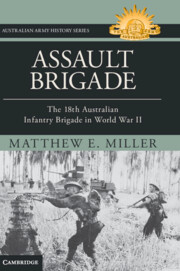Refine search
Actions for selected content:
42 results
5 - The Red Army: Leadership and Command
- from Part II - Opposing Forces
-
-
- Book:
- The Cambridge Companion to the Nazi-Soviet War
- Published online:
- 13 November 2025
- Print publication:
- 20 November 2025, pp 90-103
-
- Chapter
- Export citation
Chapter 3 - Viva l’Italia!
-
- Book:
- Emigrant Soldiers
- Published online:
- 05 June 2025
- Print publication:
- 26 June 2025, pp 50-72
-
- Chapter
- Export citation
Chapter 9 - Dictatorship, Occupation and Internment
-
- Book:
- Emigrant Soldiers
- Published online:
- 05 June 2025
- Print publication:
- 26 June 2025, pp 185-222
-
- Chapter
- Export citation
Chapter 1 - Sons of Sunny Italy
-
- Book:
- Emigrant Soldiers
- Published online:
- 05 June 2025
- Print publication:
- 26 June 2025, pp 1-29
-
- Chapter
- Export citation

Emigrant Soldiers
- Mobilising Italians Abroad in the First World War
-
- Published online:
- 05 June 2025
- Print publication:
- 26 June 2025
Introduction
-
-
- Book:
- Mobilising the Australian Army
- Published online:
- 23 May 2025
- Print publication:
- 30 May 2025, pp 1-10
-
- Chapter
- Export citation
Chapter 15 - The Kangaroo Exercise Series, 1989–1995
- from Part 6 - Deployment challenges
-
-
- Book:
- Mobilising the Australian Army
- Published online:
- 23 May 2025
- Print publication:
- 30 May 2025, pp 320-343
-
- Chapter
- Export citation
Chapter 1 - The Australian Army, mobilisation and its recent intellectual history
- from Part 1 - Mobilising an army
-
-
- Book:
- Mobilising the Australian Army
- Published online:
- 23 May 2025
- Print publication:
- 30 May 2025, pp 12-28
-
- Chapter
- Export citation
Chapter 17 - Organising for operations
- from Part 6 - Deployment challenges
-
-
- Book:
- Mobilising the Australian Army
- Published online:
- 23 May 2025
- Print publication:
- 30 May 2025, pp 368-386
-
- Chapter
- Export citation
Chapter 16 - Auditing force projection
- from Part 6 - Deployment challenges
-
-
- Book:
- Mobilising the Australian Army
- Published online:
- 23 May 2025
- Print publication:
- 30 May 2025, pp 344-367
-
- Chapter
- Export citation

Mobilising the Australian Army
- Contingencies and Compromises Over More than a Century
-
- Published online:
- 23 May 2025
- Print publication:
- 30 May 2025
3 - ‘Wartime Cultural Changes’ (1914–1918)
-
- Book:
- The European Art Market and the First World War
- Published online:
- 10 April 2025
- Print publication:
- 17 April 2025, pp 105-145
-
- Chapter
- Export citation
5 - War and Peace
-
- Book:
- Exhibitionist Japan
- Published online:
- 06 February 2025
- Print publication:
- 13 February 2025, pp 125-155
-
- Chapter
- Export citation
Chapter 2 - Reading, Feeling, Acting
- from Part I - Protest
-
- Book:
- Vivisection and Late-Victorian Literary Culture
- Published online:
- 30 January 2025
- Print publication:
- 06 February 2025, pp 49-70
-
- Chapter
- Export citation

Assault Brigade
- The 18th Australian Infantry Brigade in World War II
-
- Published online:
- 25 October 2024
- Print publication:
- 12 August 2024
Thai Habitus in Contemporary Society: Paving the Way for Tackling Inequality
-
- Journal:
- TRaNS: Trans-Regional and -National Studies of Southeast Asia / Volume 13 / Issue 1 / May 2025
- Published online by Cambridge University Press:
- 27 August 2024, pp. 107-132
-
- Article
- Export citation
Chapter 1 - An introduction to the brigade
-
- Book:
- Assault Brigade
- Published online:
- 25 October 2024
- Print publication:
- 12 August 2024, pp 6-27
-
- Chapter
- Export citation
2 - The BJP’s Ideological Heterodoxy
-
- Book:
- The New Experts
- Published online:
- 09 May 2024
- Print publication:
- 16 May 2024, pp 17-59
-
- Chapter
- Export citation
Glitter and Graffiti: Labour, Expertise and the Feminist Remaking of Mexican National Heritage
-
- Journal:
- Journal of Latin American Studies / Volume 56 / Issue 2 / May 2024
- Published online by Cambridge University Press:
- 30 May 2024, pp. 305-328
- Print publication:
- May 2024
-
- Article
-
- You have access
- Open access
- HTML
- Export citation
2 - The Negotiation of the WHO Framework Convention on Tobacco Control
-
- Book:
- Weaponising Evidence
- Published online:
- 11 January 2024
- Print publication:
- 01 February 2024, pp 31-113
-
- Chapter
- Export citation
